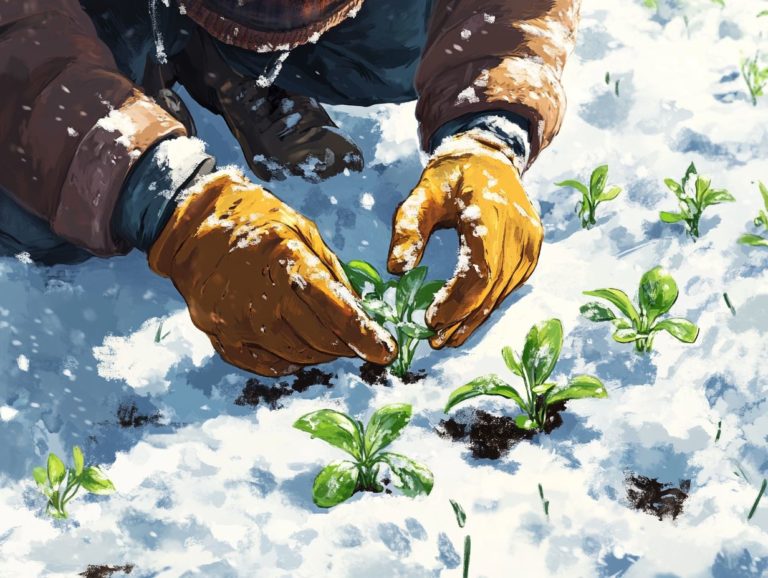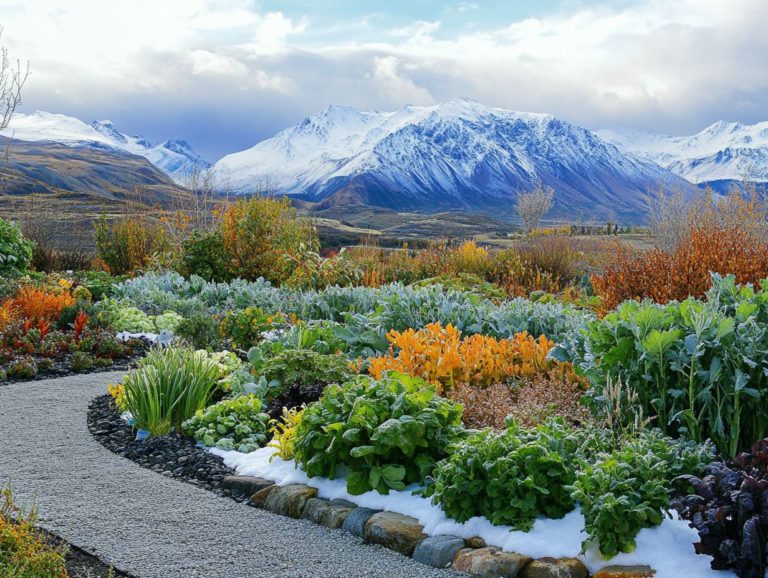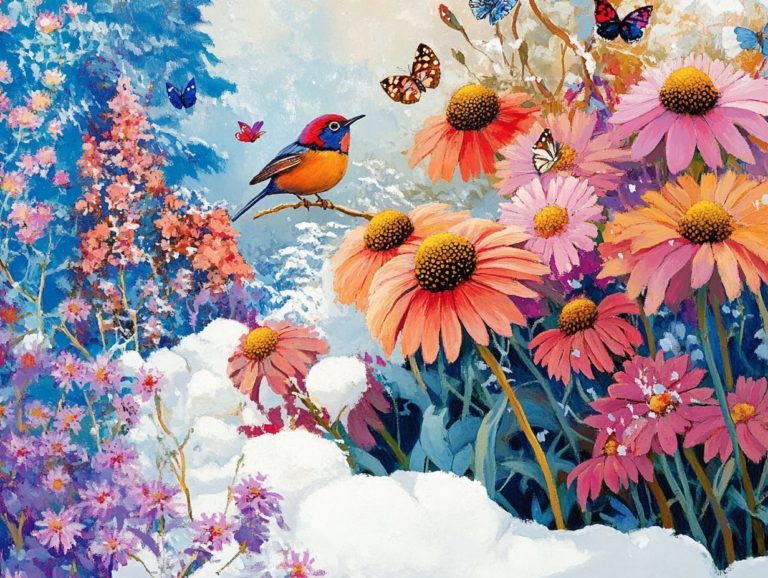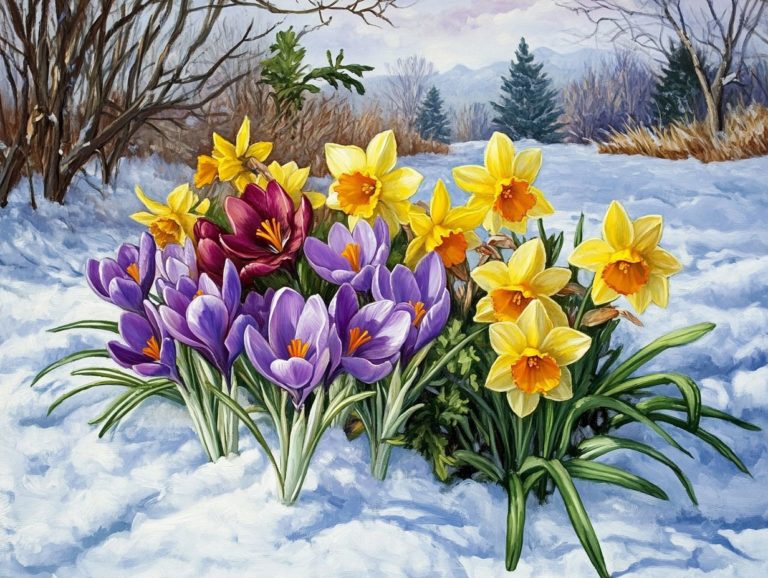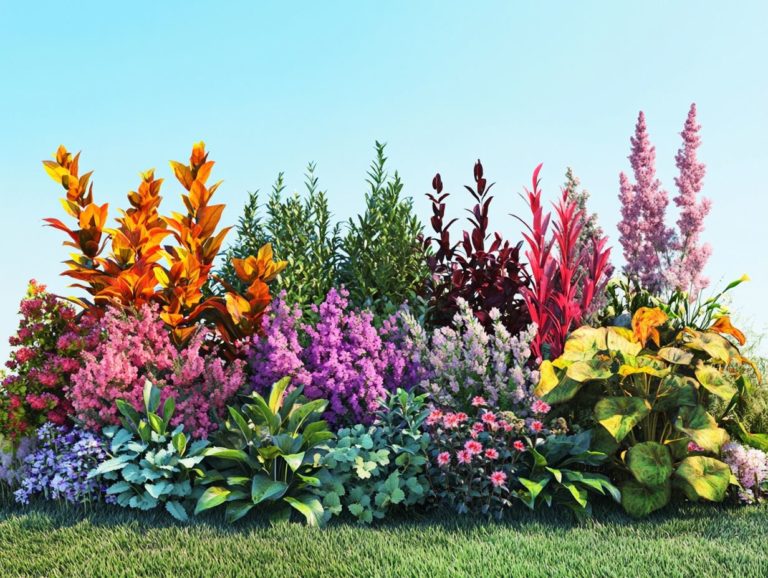Best Annuals for Cold-Climate Gardening
Get ready to transform your chilly garden into a burst of colors! Gardening in cold climates brings its own set of challenges, but it also provides a unique opportunity to feature a stunning collection of annual flowers that flourish in cooler temperatures.
Imagine your garden transformed into a vibrant display, with cheerful pansies and striking zinnias adding splashes of color. This article delves into the best annuals for chilly conditions, offering essential tips for selecting and nurturing these resilient plants, along with strategies to extend their blooming season.
With the right approach, you can ensure your garden thrives beautifully, even in the cold.
Contents
Key Takeaways:
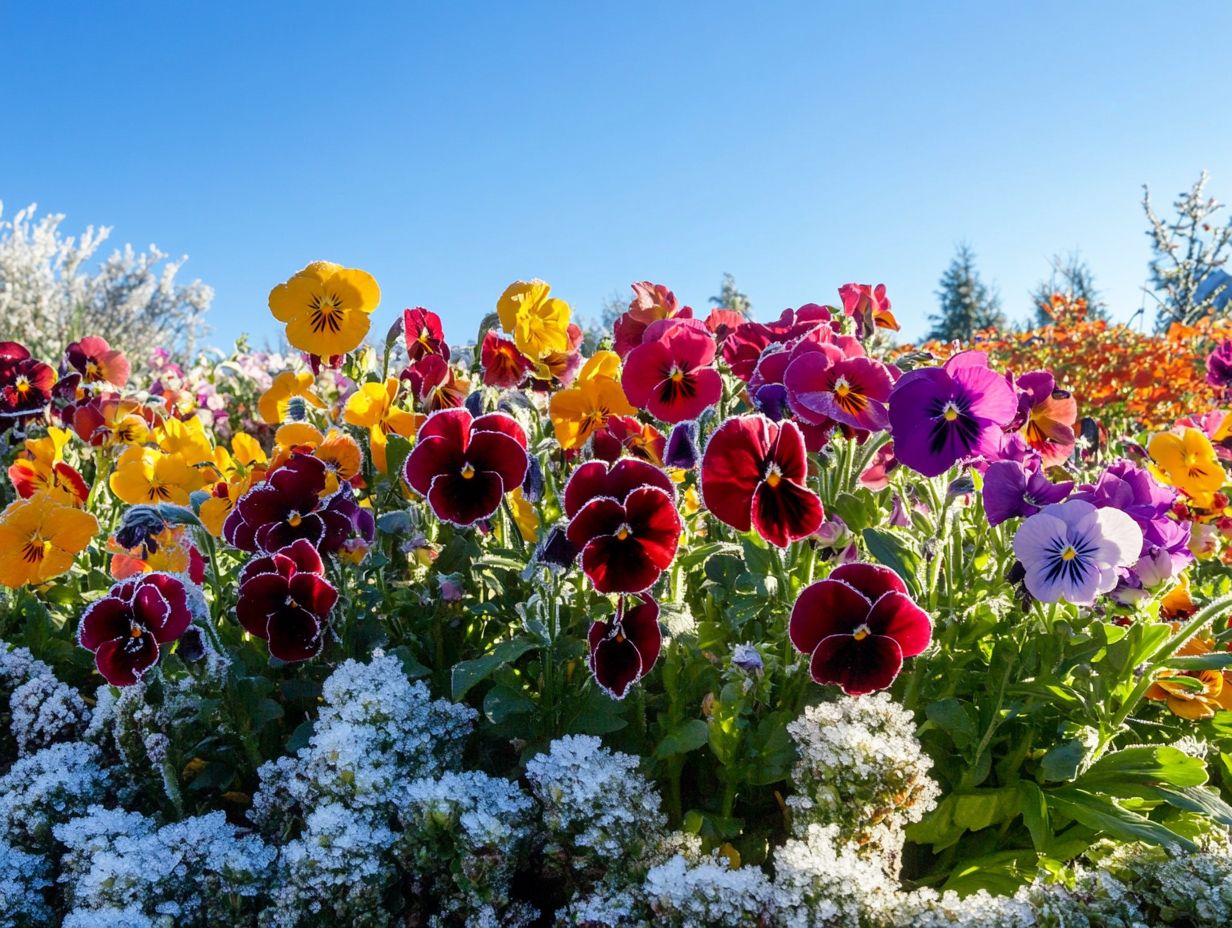
- Pansies, snapdragons, and petunias are top choices for cold-climate gardening due to their ability to withstand low temperatures.
- When choosing annuals for cold-climate gardening, consider factors such as hardiness, sun exposure, and soil conditions.
- Prepare your garden by improving the soil, mulching, and providing adequate drainage before planting annuals in a cold climate.
1. Pansies
Pansies are the cherished cool-season annuals that gardeners adore for their vibrant colors, making them a top pick for creating lively gardens in early spring or during gentle frosts.
These easy-to-grow beauties are not just frost-tolerant; they boast a rich history and a stunning array of colors that can elevate any garden landscape with their cheerful hues.
Imagine shades ranging from deep purples and bright yellows to soft whites and fiery reds pansies can truly illuminate any garden bed or container. They thrive in cooler temperatures and prefer well-drained soil. Planting them in early spring or fall will set the stage for optimal growth.
When you plant pansies, position them 6 to 8 inches apart to allow for ample airflow and full sun exposure. These blooms also attract beneficial insects like bees and butterflies, enriching your garden’s ecosystem.
Historically, pansies symbolize love and thoughtfulness. They are a meaningful addition to your outdoor space. For the best results, remember to regularly deadhead removing spent blooms helps encourage more flowers and water them to ensure these delightful blooms flourish all season long.
2. Snapdragons
Snapdragons are enchanting cool-season annuals that infuse your garden with vibrant blooms and a delightful fragrance. They are a top choice for those who cherish aromatic flowers in their landscapes.
With a magnificent range of sizes from impressive varieties reaching up to three feet tall to compact types that fit beautifully along borders these flowers are wonderfully versatile.
They also showcase an array of colors, including striking reds, pinks, yellows, and even whites, allowing you to create eye-catching combinations in your garden beds. These plants thrive in well-drained soil and bask in plenty of sunlight, though they enjoy a bit of afternoon shade in warmer climates.
Regular watering and deadheading removing spent blooms are key to encouraging more flowers. When transplanting, handle the roots with care, and consider planting them in clusters to attract beneficial insects like bees and butterflies, enhancing pollination in your garden.
3. Petunias
Petunias are the epitome of versatility and low maintenance in the world of annuals. They flourish in cool temperatures, gracing your garden with a stunning array of vibrant colors that can elevate any landscape into a tapestry of delightful blooms.
With a myriad of varieties available, you can choose grandiflora for their large, eye-catching flowers or multiflora for a more compact and resilient option. Petunias thrive in full sun, needing at least six hours of direct light each day to truly shine.
Feel free to mix and match different types to create mesmerizing arrangements that are sure to captivate onlookers. Starting seeds indoors is a breeze just sow them in a seed starter mix, keeping the soil lightly moist and warm to encourage germination.
Once your petunias take root, regular deadheading will keep them blooming beautifully throughout the season. This ensures they remain a vibrant highlight in your garden.
4. Alyssum
Sweet Alyssum is a lovely flower that grows in cooler seasons, bringing charm to your garden with its fragrant foliage and ability to attract beneficial insects. It s the perfect addition, especially during late winter or early spring.
When planting this lovely flower, timing is everything. It thrives in cooler temperatures, so sow it directly in your garden during early spring or even in the fall for the best results. As a nectar source, Sweet Alyssum not only enhances the allure of your garden for butterflies and bees, but it also plays a significant role in fostering a healthier ecosystem.
Picture your garden bursting with color and life with the low-growing, cascading nature of Sweet Alyssum, filling in gaps between taller perennials or lining your garden paths beautifully. For optimal growth, ensure your soil is well-drained, meaning it allows water to flow through easily, and water your plants every few days to keep them healthy.
Don t forget to deadhead wilted flowers; this simple task encourages continual flowering throughout its growing season, keeping your garden vibrant and alive. Start planting Sweet Alyssum today for a vibrant spring garden!
5. Calendula
Calendula, often known as pot marigold, is a resilient cool-season annual celebrated for its cheerful colors and rich history. It s an excellent choice for those looking to infuse vibrant blooms into their gardens.
Ancient cultures admired this striking flower for its beauty and revered it for its medicinal properties. Calendula boasts impressive anti-inflammatory and antiseptic qualities, frequently found in healing ointments and salves, embodying comfort and care. It has played a role in festive events and traditional ceremonies, enhancing its significance in society.
Thriving in well-drained soil and sunny conditions, this hardy plant requires minimal attention yet rewards you with a bountiful display of blossoms. Incorporating its vibrant hues into flower arrangements not only achieves visual appeal but also adds a touch of historical charm, transforming bouquets into dramatically stunning yet meaningful compositions.
6. Dianthus
Dianthus, a beloved cool-season annual, graces your garden with stunning, colorful blooms and delightful fragrance, adding elegance while attracting beneficial insects.
This enchanting flower family includes varieties like carnations and pinks, displaying a vibrant palette ranging from bold reds and pinks to calming whites and purples. These beauties thrive in well-drained soil and bask in full sunlight, so be sure to find them a sunny spot.
To keep your Dianthus flourishing, regularly deadhead spent flowers and ensure the soil remains moist but not soggy. Propagation is easy, whether you choose to use seeds or cuttings, making it simple to expand your collection.
When arranged with care, these blossoms can transform any bouquet into a charming and fragrant centerpiece that is sure to draw admiration. Ready to attract butterflies to your garden?
7. Lobelia
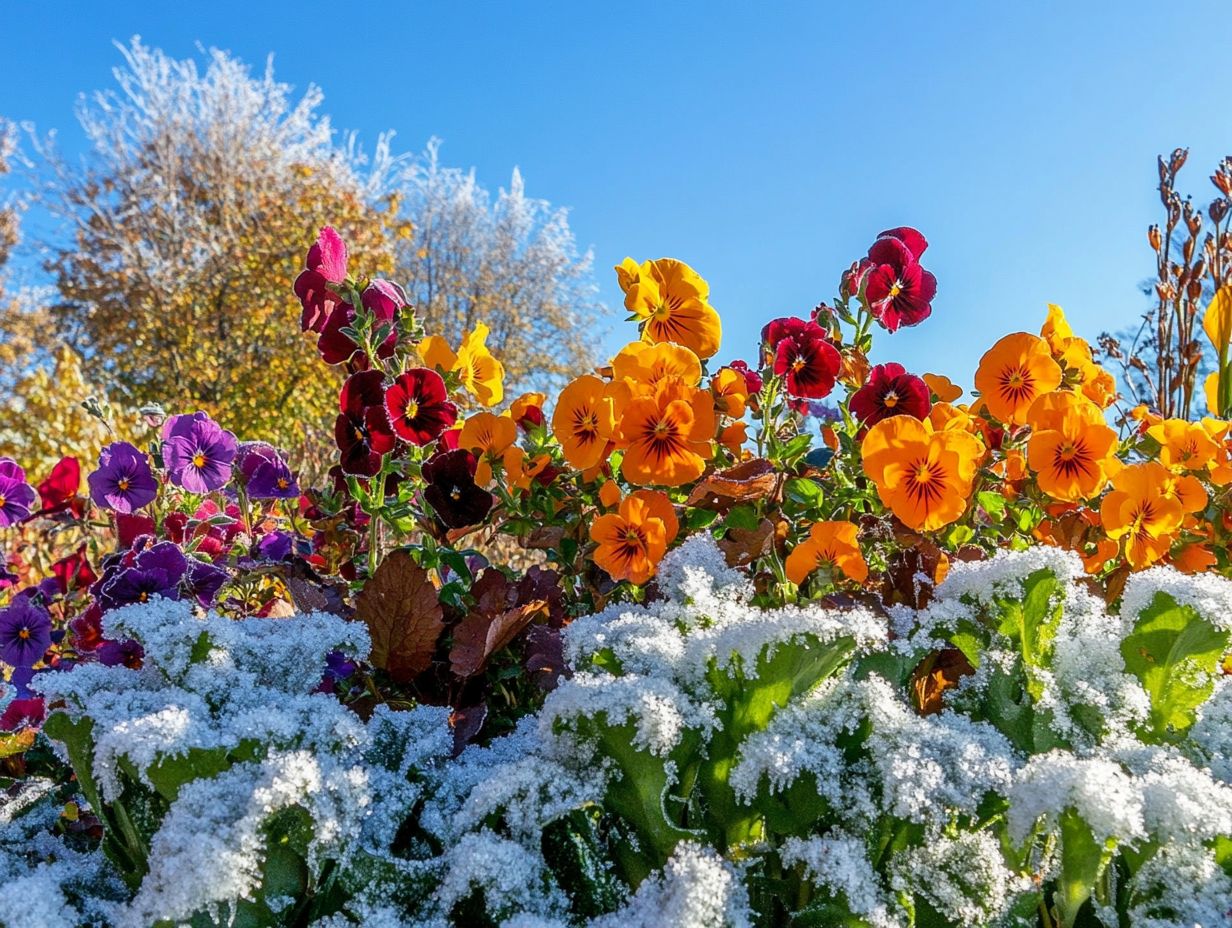
Lobelia is a graceful cool-season annual that adds vibrant colors to your garden, making it a popular choice for hanging baskets and borders. It creates stunning displays that catch the eye and elevate any outdoor space.
With a range of varieties, such as the trailing Lobelia erinus or the upright Lobelia cardinalis, you can select the perfect type to suit your landscape needs. These plants thrive in rich, well-drained soil and require regular watering to maintain their health and vibrant hues.
When you pair lobelia with other summer bloomers like petunias or marigolds, you achieve stunning color contrasts that truly enliven your garden. Their attractive flowers also attract beneficial insects like bees and butterflies, making lobelia an excellent choice for eco-friendly gardens dedicated to supporting local wildlife.
8. Violas
Violas are delightful cool-season annuals that bring cheerful colors to your garden. They add beauty and charm to your flower arrangements.
These versatile plants come in many varieties, each showcasing unique patterns and shades. They are perfect for complementing any garden aesthetic. Their adaptability means they thrive in partial to full sun and flourish in well-drained soil. It’s crucial to keep the soil consistently moist just avoid letting it get soggy.
As a gardener, you ll find that these vibrant blooms tolerate cooler temperatures. They also make good partners in the garden. When mixed with other flowering varieties, they create a stunning tapestry of color. With attentive care, transform mundane spaces into lively landscapes!
9. Sweet Peas
Sweet Peas are enchanting cool-season annuals known for their sweet smell and climbing abilities. They are perfect for vertical gardening and creating stunning floral displays.
To cultivate these charming plants, start by selecting well-drained soil in a sunny location. Sow the seeds directly into the ground or begin them indoors several weeks before the last frost to give them a head start.
As your seedlings develop, providing support like trellises or netting is essential. This allows them to climb and reach their full potential. Their delightful scent enhances your garden and attracts beneficial insects, such as bees and butterflies, vital for pollination and ecological balance.
10. Nasturtiums
Nasturtiums are vibrant cool-season annuals that bring a splash of color to your garden. They are both decorative and edible.
These captivating plants brighten up your flower beds and add a unique peppery flavor to culinary dishes. Incorporate the leaves and flowers into salads, sandwiches, or use them as a lively garnish.
Beyond their culinary charm, nasturtiums are low-maintenance and thrive in well-drained soil with plenty of sunlight. This makes them an excellent choice for gardeners of all experience levels. They also attract pollinators and predatory species, helping create a balanced ecosystem while providing stunning bursts of color.
11. Impatiens
Impatiens are the go-to cool-season annuals that flourish in shady spots. They infuse even the dimmest corners of your garden with a dazzling array of colors.
You have a delightful selection to choose from, including traditional impatiens, New Guinea impatiens, and trailing impatiens each with its own unique charm. Traditional impatiens thrive in partial to full shade, while New Guinea impatiens are more sun-savvy, allowing greater versatility in garden design.
To keep them looking their best, provide consistent watering and well-draining soil. This promotes healthy growth and a lush appearance. For stunning visual impact, pair them with contrasting flowers or foliage. Mixing different varieties adds texture and keeps your garden lively and colorful throughout the season.
12. Begonias
Begonias are exquisite cool-season annuals, celebrated for their ornamental foliage and vibrant blooms. They enrich your garden landscapes with texture and depth.
With a diverse array of species, such as tuberous, wax, and rex begonias, each type brings unique charm suited for various settings. Tuberous begonias flourish in shaded areas, while wax begonias thrive in sunny spots, demonstrating resilience across different climates.
To ensure these plants thrive, provide well-draining soil, maintain consistent moisture, and protect them from frost. Their brilliant colors can elevate any garden into a stunning masterpiece. They also shine in flower arrangements, adding a lively splash of color that enhances any indoor space or event.
13. Marigolds
Marigolds are delightful cool-season annuals. They are known for their vibrant hues and impressive ability to keep pests at bay!
These resilient plants add a burst of sunny yellow or rich orange to your landscape. They are low-maintenance; just ensure you provide them with well-drained soil and moderate watering, and they ll thrive.
Their aromatic blooms repel tiny worms and other pesky insects. This helps create a healthier garden! Marigolds also attract beneficial insects like ladybugs and lacewings.
If you aim to elevate your garden’s aesthetics, consider planting marigolds in clusters. You can also intersperse them with other flowering plants. This strategy creates stunning visual displays that draw the eye, transforming your garden into a functional yet enchanting retreat.
14. Zinnias

Zinnias are captivating cool-season annuals. They are celebrated for their vibrant colors and long-lasting blooms, making them a top choice for stunning flower arrangements!
With a variety of options, including the beloved ‘Benary’s Giants’ and the delightful ‘Zahara’ series, these flowers adapt beautifully to different settings. They thrive in well-drained soil and bask in full sun.
Regular deadheading will not only prolong their flowering period but also keep the plants healthy and lively. To attract butterflies and bees, think about planting a mix of zinnia varieties in clusters.
This approach enhances their visual allure while boosting pollinator interest. These resilient beauties can also be cut and arranged into striking bouquets, adding a cheerful touch to any indoor space!
15. Coleus
Coleus is a remarkable cool-season annual that transforms any ornamental landscape. Its vibrant foliage elevates your gardening experience to new heights!
With a dazzling array of shapes, sizes, and colors, these plants cater to multiple gardening styles and preferences. Whether you prefer deep burgundy or bright lime green, coleus offers a rich spectrum of hues.
Caring for them is simple just provide well-draining soil and partial shade. They ll thrive as striking focal points or integrated into mixed plantings!
This creates unique combinations that capture attention and breathe life into your outdoor spaces.
How to Choose the Right Annuals for Cold-Climate Gardening?
Choosing the right annuals for cold-climate gardening requires attention to detail. Additionally, consider incorporating perennial herbs for cold-climate gardens that can withstand frost and tackle the unique challenges posed by temperature fluctuations throughout the growing season!
Beyond frost tolerance, consider your color preferences. Think about how these plants will enhance your garden’s overall aesthetic. Compatibility with other plants is equally important.
Some annuals thrive alongside perennials, while others may compete for nutrients. This competition can create unnecessary challenges.
Varieties such as pansies, snapdragons, and calendula not only brave the chill but also introduce vibrant splashes of color to your garden beds. By understanding these factors, you can significantly elevate the beauty and resilience of your cold-weather garden!
Start cultivating a flourishing landscape that thrives even in less-than-ideal climates today!
What Factors Should Be Considered When Choosing Annuals for Cold-Climate Gardening?
When selecting annuals for cold-climate gardening, you’ll need to weigh several factors, such as frost tolerance (the ability of a plant to survive freezing temperatures without damage), the ability to thrive indoors during the chillier months, and how well they adapt to temperature fluctuations. Consider choosing the best plants for small cold-climate gardens to enhance your garden’s resilience.
One of the most important considerations is soil type. Well-draining, loamy soils are your best bet for fostering strong root systems.
Sunlight exposure also varies among plants some, like pansies and snapdragons, thrive in partial shade, while others, such as nasturtiums, crave full sun.
Water requirements can differ significantly, too. Certain varieties may flourish with minimal moisture, while others demand consistent hydration to stave off wilting.
For those in colder regions, hardy annuals like calendula and sweet alyssum not only withstand frost but also infuse vibrant color into winter landscapes. Additionally, exploring the best cover crops for cold-climate gardens can provide superb choices for gardeners seeking both resilience and beauty during the colder months.
How to Prepare Your Garden for Planting Annuals in a Cold Climate?
Preparing your garden for planting annuals in a cold climate means you need to grasp the essentials of proper planting instructions, effective seed starting techniques, and selecting cold-climate plants for urban gardens to ensure successful growth.
Start by amending your soil with organic matter like compost; this will significantly boost fertility and drainage, creating an optimal environment for your plants to flourish.
Timing is key wait until after the last frost date to plant to prevent those delicate seedlings from facing any damage.
To protect your young plants from unexpected late frosts, use row covers or cloches. These handy tools trap warmth while shielding your plants from chilly winds. By paying careful attention to these preparations, you not only increase your plants chances of thriving but also elevate the overall beauty of your garden.
What Are Some Tips for Maintaining Annuals in a Cold Climate?
Maintaining annuals in a cold climate calls for specific strategies to navigate temperature drops and ensure the health and longevity of your plants throughout the gardening season. Choosing the best plants for windy cold-climate gardens can make a significant difference.
To achieve this, you ll need to establish a consistent watering schedule that adapts to changing weather conditions, since colder temperatures can significantly affect soil moisture levels.
Incorporating a balanced fertilization routine will encourage vigorous growth, but remember to adjust the frequency during the dormant winter months to avoid overwhelming your plants.
It s also vital to keep a vigilant eye out for any signs of pests or diseases, especially as the weather cools, since certain infestations can thrive in humid conditions.
Making seasonal adjustments in care, such as protecting roots with mulch or relocating containers to more sheltered areas, will further enhance the resilience of your beautiful blooms.
How Can You Extend the Blooming Season for Annuals in a Cold Climate?
To extend the blooming season for your annuals in a cold climate, you can employ several effective techniques. Consider growing them indoors, selecting varieties with longer flowering periods, and using protective measures during temperature drops.
By utilizing cold frames and row covers, you can create a microclimate that shields your tender plants while still allowing sunlight to nourish them.
When choosing frost-tolerant varieties, take the time to understand the specific characteristics that enable these plants to endure chilly conditions and continue to flourish.
Careful planning for staggered planting not only enhances the visual appeal of your garden but also ensures that blooms are consistently available throughout the growing season. This strategy maximizes garden aesthetics and promotes healthy growth, giving a boost to both your perennials and annuals alike.
Frequently Asked Questions

What Are the Best Annuals for Cold-Climate Gardening?
Some of the best annuals for cold-climate gardening include pansies, petunias, snapdragons, sweet alyssum, and fragrant plants.
Can I Grow Annuals in a Cold Climate?
Yes, you can still grow annual flowers in a cold climate as long as you choose best plants for cold-climate succession planting that are suitable for colder temperatures and provide proper care and protection.
Start planning your cold-climate garden today! With the right annuals, you can discover the best cold-weather annuals and enjoy vibrant blooms even in chilly weather!
How long do annuals typically last in cold climates?
Annuals last for one growing season, usually around 3-4 months in colder regions.
Some types may thrive longer with proper care, like regular pruning.
What is the best time to plant annuals in a cold climate?
Plant annuals after the last light frost date, which varies by location.
Wait until the soil is warm enough for planting.
Do annuals need special care in cold climates?
Yes, annuals need extra care to thrive in cold climates.
This includes watering, mulching, and protecting them from frost and strong winds.
Can I grow annuals in containers in a cold climate?
Absolutely, you can grow annual flowers in containers!
Just choose cold-tolerant types and take care of them.
During extreme weather, move the containers to a sheltered spot.

